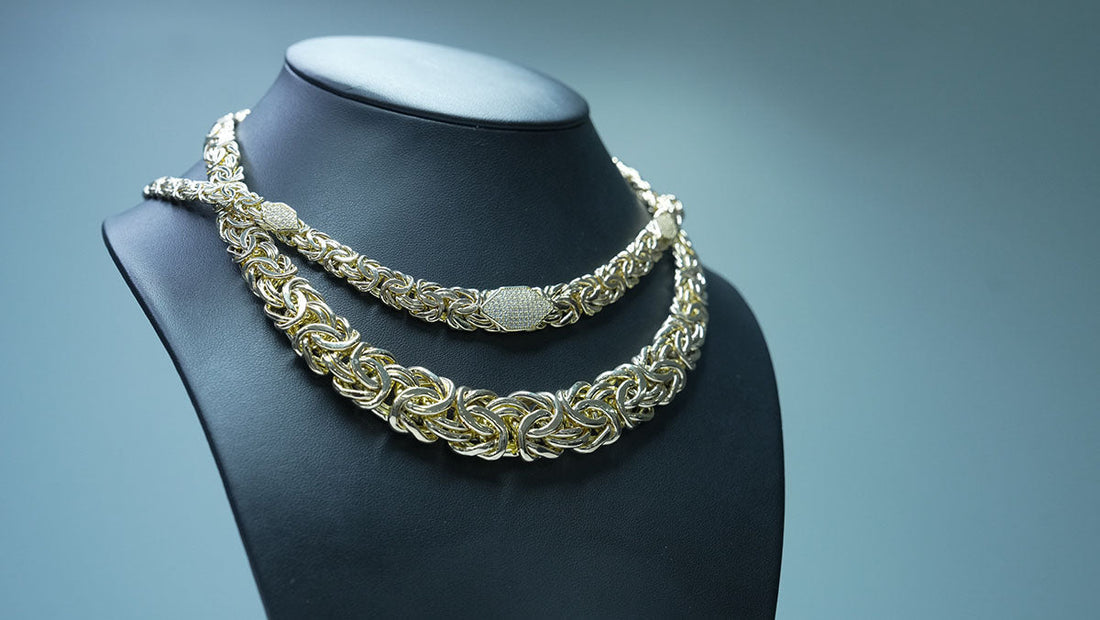
History of necklaces: from antiquity to the present day
Share
Why do we wear necklacesJust for fashion? The answer is much deeper than you might imagine. From early humans to modern runways, necklaces have been much more than adornment. They have told stories, shown power and united cultures. But how did it all begin? And the most curious: what do an Ancient Egyptian pharaoh and a modern-day influencer have in common? We tell you below.
The origin of necklaces: when it all began
The history of necklaces dates back more than 40,000 years. The earliest necklaces were not made of gold or precious stones, but of bones, shells, animal teeth or seeds. Our ancestors wore them not only for beauty: these necklaces served as protective talismans, symbols of tribal membership or even hunting trophies.
Over time, these pieces became increasingly elaborate. As mankind discovered new materials and techniques, necklaces evolved, reflecting the wealth, social status and beliefs of each era.
Egypt and Mesopotamia: symbols of power and eternity
In Ancient Egypt, necklaces were essential. Pharaohs, priests and nobles wore imposing pieces made of gold, stones such as lapis lazuli or turquoise, and shapes full of symbolism. One of the most famous designs was the necklace one of the most famous designs was the "usekh" necklace, a type of wide choker that was placed on the chest and represented divine power.
In Mesopotamia, on the other hand, necklaces also had a religious role. They were buried with the dead as protection in the afterlife. Here was born an idea that still remains: jewelry as part of our identity, even after death.

Greece and Rome: beauty, elegance and sophistication
With the Greeks, the evolution evolution of jewelry took a more artistic turn. Necklaces became more delicate, with shapes inspired by nature: leaves, flowers, animals. Beauty was the main objective.
The Romans, on the other hand, expanded the use of necklaces throughout their society. From upper class women to soldiers who wore medallions as recognition. They also pioneered the use of cameos and carved stones.
Middle Ages: faith and protection
During the Middle Ages, necklaces were charged with spirituality. Many carried crosses, religious medals or relics. Gold and silver were still present, but the focus was on faith. The first iconic necklaces iconic necklaces linked to European royalty, which would later influence Renaissance jewelry.
Renaissance and Baroque: excess and detail
With the Renaissance, art invaded every aspect of life, including jewelry. jewelry. Necklaces became more elaborate, with carefully selected precious stones. The aristocracy competed for who had the most striking piece.
During the Baroque, excess was the rule. Jewelry was large, ornate, and necklaces reflected extreme luxury. But this trend did not last forever.

Nineteenth and twentieth century: jewelry as personal expression
The industrial revolution brought new materials, new techniques, and for the first time, the possibility for more people to have access to jewelry. The necklace as a fashion accessory was born in this context. It was no longer just a symbol of wealth, but of personal style.
In the 20th century, each decade left its mark:
- 20'sLong pearl necklaces, like the ones popularized by Coco Chanel.
- 50'sdiamond chokers, inspired by Hollywood.
- 70'shippie necklaces, with natural and spiritual elements.
-
90'schokers made of fabric, leather or plastic, icons of pop culture.
Each one, a reflection of its time.
Today: between tradition and reinvention
Today, we live in a fascinating time. The past inspires the present. We see necklaces reinterpreted with new materials, minimalist designs that evoke old times, and personalized pieces that tell their own stories.
The history of necklaces is still alive, fueled by creativity and the desire for expression. Today, a necklace can signify love, strength, identity, or simply a taste for detail.
And the best part is that you choose what story to tell with yours.

What does the evolution of jewelry tell us about ourselves?
The evolution of jewelryespecially that of necklaces, is also the evolution of our emotions, beliefs and desires. In every era, people sought ways to adorn themselves, to mark moments, to protect themselves or to stand out. Although the materials change, the impulse remains the same: to wear something that says who we are.
And in a world full of options, choosing the right necklace is not just a matter of fashion. It's a choice that connects with our essence.
Today, as thousands of years ago, a necklace can make a difference. It can be your amulet, your signature, your story. That's why, at Ventura Jewelry we believe that each piece deserves to be made with intention, with soul and with respect to that story that began millennia ago... and that you are about to continue.
